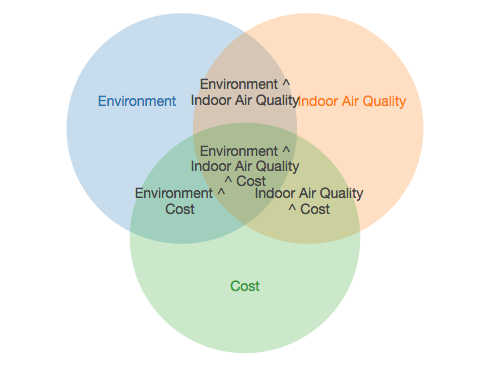This is the first part in a series of posts about creating healthy homes with natural materials for people who have cystic fibrosis. The following topics will be covered:
- Part 1 – Cystic fibrosis and how indoor air quality has an impact
- Part 2 – The design and materials choices we have chosen to create the healthiest indoor air quality
- Part 3 – Household product choices to help cystic fibrosis
I am working with Rebecca and Daniel to renovate their home, a 1930’s semi. Rebecca is a student, studying P-DTR and a pilates instructor, Daniel is a garden designer. Rebecca has Cystic Fibrosis (CF), a genetic condition affecting more than 10,800 people in the UK.
I’m really excited to be involved with this project as I mainly work in the new build environment. Creating healthy homes from scratch and renovating an existing property to be healthier are very different challenges.

Environmental considerations for the renovation
Rebecca and Daniel are also very conscious of the damage that products can have on the environment through their materials or production. This includes energy use when transporting them around the world, toxic coatings entering the water system or embodied energy in the production of the material.
When evaluating possible materials and design details our criteria are rated in the following order:
- How does it affect the indoor air quality of the house?
- How does it affect the environment?
- Does it fit within the budget?
Invariably there is a compromise of all of these.

What is Cystic Fibrosis?
People with cystic fibrosis experience a build-up of thick sticky mucus in the lungs, digestive system, and other organs, causing a wide range of challenging symptoms affecting the entire body. The gene affected by Cystic Fibrosis controls the movement of salt and water in and out of cells.
Two main areas affected are:
The lungs
A build-up of mucus in the lungs causes chronic infections, meaning that people with cystic fibrosis struggle with reduced lung function and have to spend hours doing physiotherapy and taking nebulised treatments each day. Exacerbations (a sudden worsening of health, often owing to infection) can lead to frequent hospitalisation for weeks at a time, interfering with work and home life.
The digestive system
As the pancreas becomes blocked with mucus, enzymes required for digesting food cannot reach the stomach. People with cystic fibrosis often need to take more than 50 tablets a day to help digest food and keep respiratory symptoms in check.
What are the key elements for a healthy home environment for someone with Cystic Fibrosis?
Rebecca says:
The main aim for our home is to improve indoor air quality as much as possible, which should be important to everyone but with having CF it is especially important to me.
The top things to reduce are:
- VOCs
- Mold growth
- Bacterial growth
- Dust mites
Now, it should be said that no two people with cystic fibrosis would react the same. Everyone is unique and will have their own relationship with CF and their own range of symptoms. Some people have relatively stable lung function, while others struggle with this the most. Some require enzymes with every meal to help digest their food, while others don’t need any at all. But, as a general rule, reducing the items on this list can help.
Why is it important to improve indoor air quality for people with cystic fibrosis?
Pulmonary exacerbations in cystic fibrosis accelerate the progression of the disease/shorten life and increase the burden of disease, with a negative impact on lung function and quality of life.
It has been found that acute increases in air pollution were associated with an increased likelihood of receiving additional antibiotic treatment due to a CF exacerbation. For each increase in the concentration of every pollutant by 10-µg/m³, the risk of receiving antibiotics in the next 48 hours increased significantly.
This suggests patients may experience fewer pulmonary exacerbations than they otherwise would by avoiding areas where there is sustained high air pollution and/or areas susceptible to acute increases in air pollution.
What can be done to improve indoor air quality for a person with cystic fibrosis?
Here is a list of ways to improve indoor air quality. As said before, all people with Cystic Fibrosis are different and what works for some may not for others. We will be addressing These items more thoroughly in [Part 2 – The design and materials choices we have chosen to create the healthiest indoor air quality] and [Part 3 – Household product choices to help cystic fibrosis]
- Keep your home well ventilated
Good ventilation will help to stop build-ups of all pollutants and moisture in the home. This can be as simple as creating a good through flow by opening a top floor window and a ground floor window. This is especially important while cooking or after showering when moisture is at it’s highest. This can also be done with a Positive Input Ventilator (PIV), which requires no user input. Regular changing of filters is a must - Reduce condensation
Damp leads to condensation, which encourages mould and other fungi to grow. The ideal humidity level in your home should be between 40-60%, at this level it is much harder for mites, moulds and fungi to thrive.
Closing doors and using a good extractor fan when cooking or showering can help to keep your home free from damp, also drying your washing outside if possible.
Damp and mould in a house can be because of bad design or materials choices. Daniel fixed a damp issue in the house simply by cleaning out the airbricks, which ventilate under his floorboards. Cement renders and emulsion paints also trap moisture in a house – so try to remove or don’t use these [More on this in Part 2 – The design and materials choices we have chosen to create the healthiest indoor air quality] - Remove Dust Traps
Dust collects on any horizontal surface, so try reducing the number of horizontal surfaces that can’t be easily cleaned. Fabrics and pads are a natural trap for dust particles. By exchanging carpeted flooring with wood and curtains with blinds, you will reduce the dust in your home - Reduce Mould Traps
Mould will usually grow in areas of high humidity. Your average shower cubicle will have many nooks and crannies for water to sit unnoticed and mould can grow. Either dry these surfaces after use or better yet install bathroom and kitchen fixtures that won’t trap water. - Add a plant
Adding a plant can be a great way to naturally filter the air, particularly a spider plant Chlorophytum comosum, and aloe vera. Mother in law’s tongue ((sanseveria) is a great plant for the bathroom since it does well in low light, will love the moist conditions and filters out many of the pollutants found in cleaning products, tissues, toilet paper and more.Rebecca developed fungus chest infections from working at florists; thankfully her infection went away once she stopped working in that environment. So for her particular reactions, it can be advised not to be in enclosed air spaces with soil. This could have been because of the high concentration of cut flowers which are dosed with chemical anti fugal treatments in the water.
- Use natural cleaning products
Many cleaning products contain high levels of VOCs and so cleaning with them can actually create worse air quality. Try to switch to natural cleaning, laundry and personal healthcare products. [Part 3 – Household product choices to help cystic fibrosis] - Avoid Smoke and Fumes
With Cystic Fibrosis, it is very important that smoke is kept far away from the home. Also consider other forms of pollution you should avoid; be careful not to run your car in the garage any longer than necessary and keep the garage door open for a few minutes to let the area air out before entering the house. What’s more, open the windows and turn on a fan if something burns on the stove. - Pet options
If you are thinking of getting a pet, for most, a hypoallergenic (non shedding) pet is a solid option. A furry pet should be regularly groomed, brushed and bathed to reduce any dust or hair that could be released into the air. Also, keep their bed frequently laundered and their crate area well swept out on a frequent basis to eliminate any shedding or dirt that may have been tracked in.
– Rebecca is luckily not affected by pet allergies and has 3 cats!
Part 2 will be along soon where we will discuss the materials and design choices we are making on Rebecca and Daniels’ home to improve their indoor air quality.
While you wait, why not check out Rebecca’s fantastic project to help save the Orangutans
– http://www.oranguchange.com/
References:
www.cysticfibrosis.org.uk
http://www.ukgbc.org/sites/default/files/How%20to%20deliver%20Healthy%20Buildings.pdf
https://www.blf.org.uk/support-for-you/your-home-and-your-lungs/improving-air-quality
http://cfunite.org/research/impact-of-air-pollution-on-cystic-fibrosis-pulmonary-exacerbations-a-case-crossover-analysis/
https://www.onehourairconditioningcharlotte.com/10-tips-for-cystic-fibrosis-indoor-air-quality/
http://www.criticalcactus.com/ideal-home-humidity-levels/


